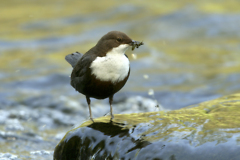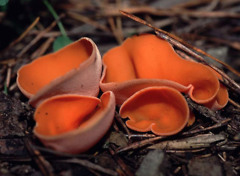The beauty and charm of this landscape lies in the expansiveness and tranquillity of its forests. When hiking, skiing and relaxing you can enjoy the healthy air at high altitudes. In the south of the Nature Park, the mountains reach heights of almost 800 metres. Forests cover broad stretches of the area. Deeply-etched creek valleys lie between the mountains. In some streams and rivers, the rare dipper can be observed looking for food underwater in the clean, cool waters. In this region you will also find evidence of the former internal German border, which today represents a valuable habitat and biotope network for rare animals and plants. There are also opportunities today to experience nature that has long been untouched along the 'Green Belt'.
Simply move the cursor over the map and follow the information behind the landmarks and hiking trails of this natural space!



Special animal species:
bats, dippers, white wagtails, Eurasian eagle owls, boreal owls, kestrels, grass snakes, smooth snakes, common lizards, garden dormice
Special plants:
rare mosses, lichens and fungi, orchids, pillwort, green and brown spleenwort
Landscape profile of the Federal Office for Nature Conservation
The 'High Thuringian Slate Mountains' landscape is a high plateau densely forested with conifers, parts of it forming peneplains. It lies at a height of up to 900m above sea level. Due to the high amount of precipitation in this area, raised bogs have formed in some places. At present, a large part of the area is used for forestry (spruce forest). The agricultural area is limited and consists mainly of grassland. On the slopes are former agricultural terraces that are largely unused. The main part of the wooded area consists of cultivated spruce mountain forests. Deciduous and mixed forests are nowadays found on only a few steep slopes. The open land consists of matgrass fields and golden oat grass meadows. Today's potential natural vegetation above 800m would be a small mixed mountain forest rich in small reed, or small areas of blueberry/fir mixed forest. Large uninterrupted spaces exist in this area between Goldistthal, Steinheid and Neuhaus (partly belonging to the 'Wurzelbergfarnde' and 'Löschleite' nature reserves), as well as between Neuhaus, Katzhütte and Oberweissbach and between Steinach, Steinheit and Mengersreuth-Hämmern (parts of which belong to the 'Leierloch' nature reserve and 'Röthengrund' reserve). The two largest protected areas, which comprise about one third of the landscape, are the 'Western Thuringian Slate Mountains' and 'Northern Thuringian Slate Mountains with Schwarzatal' EU bird sanctuaries.